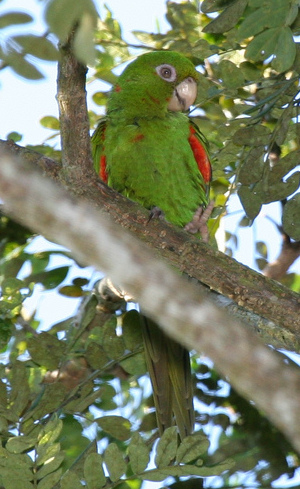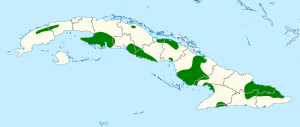Cuban parakeet facts for kids
Quick facts for kids Cuban parakeet |
|
|---|---|
 |
|
| Conservation status | |
| Scientific classification | |
| Genus: |
Psittacara
|
| Species: |
euops
|
 |
|
The Cuban parakeet (Psittacara euops) is a beautiful bird that lives only on the island of Cuba. It belongs to the family of parrots found in Africa and the New World. Sadly, it is considered a Vulnerable species, meaning its population is at risk.
Contents
What is the Cuban Parakeet?
The Cuban parakeet is a type of parrot. For a while, scientists called it Aratinga euops. But since about 2013, it has been placed in a different group, the Psittacara genus. This bird is unique and doesn't have any subspecies.
How to Identify a Cuban Parakeet
Cuban parakeets are about 22 to 29 cm (8.7 to 11 in) long. They weigh around 78 to 96 g (2.8 to 3.4 oz), which is about as much as a small apple. Both male and female parakeets look very similar.
Most of their body is a bright yellow-green color. Their belly is a bit lighter. They have cool red spots on their head, neck, and chest. Males usually have more red spots than females. The edges of their wings and the feathers under their wings are a bright red. The underside of their flight feathers and tail are a pale green or olive color.
Their eyes are light yellow. Around their eyes, the skin is bare and looks light pink to reddish-white. They have a light pink beak and pink to ivory-colored feet. Young parakeets look like the adults. However, they have very few or no red spots on their head and chest.
Where Do Cuban Parakeets Live?
The Cuban parakeet used to live all over the main island of Cuba. It also lived on Isla de la Juventud, which is also known as the Isle of Pines. But by the year 1900, they had disappeared from Isla de la Juventud.
Today, you can find them in a few separate areas. These include the Zapata Swamp and parts of several provinces like Villa Clara and Guantanamo. They also live in the western Escambray Mountains and near the Cauto River.
These parakeets live in two main types of places. One is open grasslands called savannas, which have many palm trees and scattered trees. The other is dense evergreen and semi-deciduous mountain forests. The Royal palm tree is very important to them. It grows in both types of areas and is their favorite place to build nests.
Cuban Parakeet Behavior
Cuban parakeets are very friendly birds. They usually hang out in groups called flocks. These flocks can have up to 50 birds!
Do They Migrate?
No, Cuban parakeets do not migrate. They stay in the same area all year long.
What Do They Eat?
These parakeets enjoy a varied diet. They eat seeds, both green and ripe fruits, and flower buds. They also like pollen and nectar from flowers. Scientists have found that they eat from more than 50 different kinds of plants!
How Do They Raise Their Young?
Cuban parakeets nest between February and September. They almost always nest in holes that woodpeckers have made in trees. Sometimes, they use holes in limestone cliffs too. They don't add any extra material to the nest. However, they might loosen wood chips from the inside walls of the hole to make a soft bottom.
A female parakeet usually lays two to five eggs. On average, they lay four eggs. The eggs hatch after about 24 days. The baby birds, called nestlings, stay in the nest for 55 to 60 days before they are ready to fly. The male parakeet brings food to the nest for the female. She then feeds the food to their hungry nestlings.
What Sounds Do They Make?
Cuban parakeets make many different sounds.
- When they sense danger, they make "warning calls." These sound like "erh, erh, erh, erh."
- Their "contact call" is used when they are eating. It sounds like "kkkkeeeeerrrrrrrrrrrrrr."
- They also have a "flight contact" call. They use this when they take off or land. It sounds similar to their warning call.
- During courtship, they make "smooth and short" calls. These sound like "keirp-keirp-keirp."
Status and Conservation
The IUCN (International Union for Conservation of Nature) first listed the Cuban parakeet as Threatened. Since 1994, it has been listed as Vulnerable. This means it faces a high risk of becoming endangered in the wild.
The parakeet's population is small and spread out. Experts believe there are only about 1,500 to 7,000 adult birds left. This number is also thought to be decreasing.
The biggest dangers to the Cuban parakeet are:
- Habitat loss: Their homes are being destroyed.
- Illegal trapping: People catch them illegally to sell as pets. This happens both in Cuba and for export to other countries.
Hurricanes are also becoming more frequent and stronger due to climate change. This is another possible threat to the parakeets. Cuban authorities have even suggested that the IUCN change the bird's status to Endangered. Luckily, most of the remaining parakeet groups live in areas that are somewhat protected.
See also
 In Spanish: Loro catey para niños
In Spanish: Loro catey para niños


